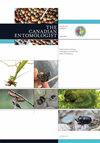夏季梨木虱(半翅目:木虱科)对雌雄气味的反应
IF 1.1
4区 农林科学
Q3 ENTOMOLOGY
引用次数: 5
摘要
摘要本文研究了梨树木虱(Cacopsylla pyricola, Förster)的性吸引过程中化学信号的作用,评价了夏季雄性和雌性木虱对雌雄产生的挥发性化学物质的反应。雄木虱被活雌木虱的气味和雌木虱的戊烷提取物所吸引。雌虫的提取物对雄虫的吸引力与活雌虫一样大,这表明雌虫产生的对雄虫有吸引力的挥发性化学物质可能通过用戊烷提取雌虫来分离。雌性不会被来自活体雌性的气味所吸引,并且倾向于避免来自雌性提取物的气味。此外,夏虫雄性和雌性不会被雄性产生的气味吸引或排斥,这些气味来自雄性的活雄虫或雄性的提取物。对雄性夏型pyricola的嗅觉测定结果与早期对该物种冬型形态的研究结果一致。本文章由计算机程序翻译,如有差异,请以英文原文为准。
Response of Summerform Pear Psylla (Hemiptera: Psyllidae) to Male- and Female-Produced Odors
Abstract
We examined the role of chemical signals in sex attraction of pear psylla, Cacopsylla pyricola (Förster), assessing the response of summerform male and female psyllids to male- and female-produced volatile chemicals. Male psyllids were attracted to odors from live females and pentane extracts of females. Extracts of females were as attractive to males as live females, suggesting that the female-produced volatile chemicals responsible for male attraction might be isolated by extracting females with pentane. Females were not attracted to odorants from live females and tended to avoid odorants from extracts of females. Furthermore, summerform males and females were not attracted or repelled by male-produced odorants from live males or extracts of males. Results of olfactometer assays using male summerform C. pyricola are consistent with results from earlier studies with the winterform morphotype of this species.
求助全文
通过发布文献求助,成功后即可免费获取论文全文。
去求助
来源期刊

Canadian Entomologist
生物-昆虫学
CiteScore
2.20
自引率
11.10%
发文量
24
审稿时长
6-12 weeks
期刊介绍:
French translation follows/le français suit Published since 1868, this peer-reviewed bimonthly publication is the official journal of the Entomological Society of Canada. Available via the internet and with hardcopy distribution to 55 countries, its research papers and notes are relevant to entomologists and other biologists around the world. In addition to being a venue for topical reviews and forum discussion, The Canadian Entomologist publishes current research in all facets of entomology, including systematics and morphology, molecular and developmental biology, ecology and behaviour, biodiversity and evolution, insect management, entomological techniques, and other relevant subject areas. Contributions are published in English or French. Authors will not pay page charges, and will experience fast, high quality reviews of their papers.Publiée depuis 1868, cette publication bimestrielle avec comité de lecture est la revue officielle de la Société d’entomologie du Canada. Disponible sur Internet et distribuée en format papier dans 55 pays, ses articles de recherche et ses notes sont pertinents pour les entomologistes et autres biologistes de par le monde. En plus d’être une plate-forme pour des revues thématiques et un forum de discussion, The Canadian Entomologist publie la recherche actuelle sur toutes les facettes de l’entomologie, incluant la systématique et la morphologie, la biologie moléculaire et développementale, l’écologie et le comportement, la biodiversité et l’évolution, la gestion des insectes, les techniques entomologiques et d’autres domaines pertinents. Les contributions sont publiées en français ou en anglais. Les auteurs ne paient aucun frais de publication, et recevront une révision rapide et de grande qualité de leurs articles.
 求助内容:
求助内容: 应助结果提醒方式:
应助结果提醒方式:


